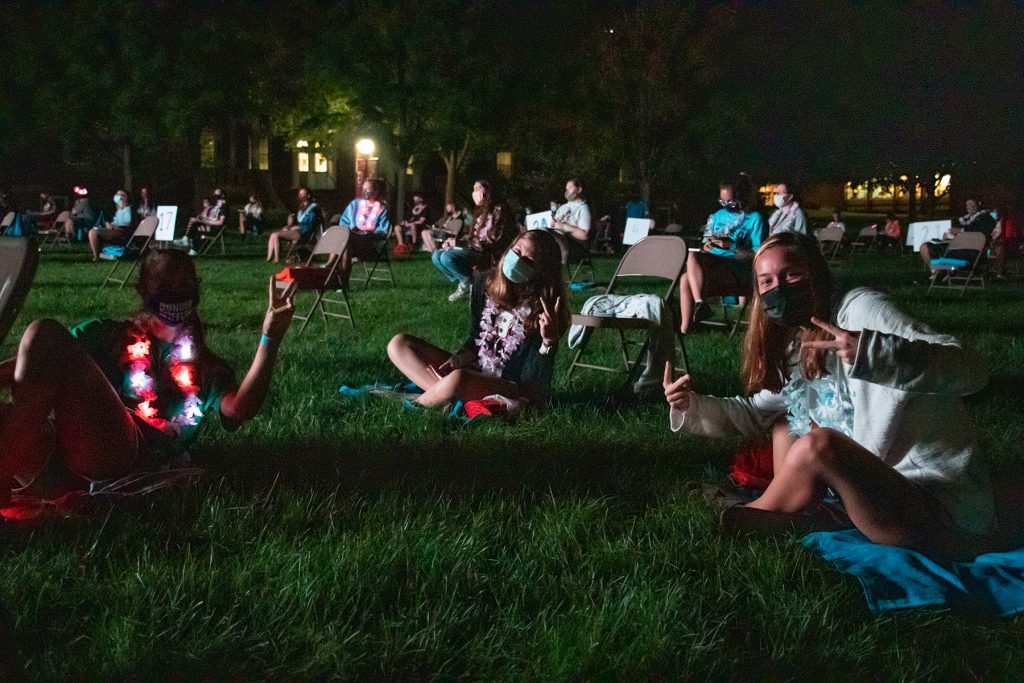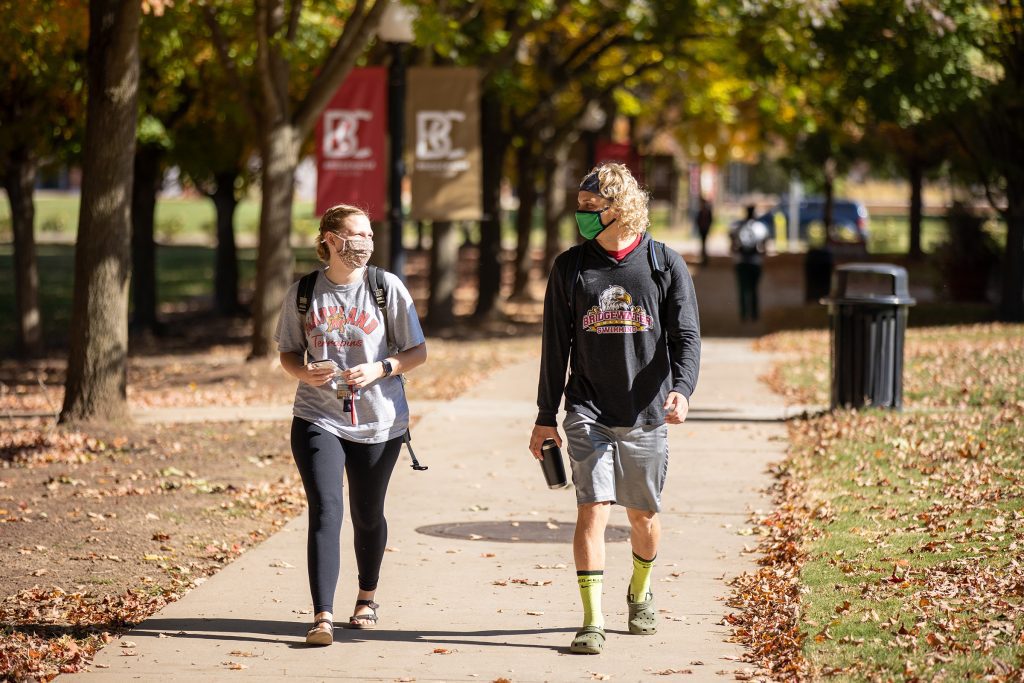By Jessica Luck
A few days before the start of the fall semester, David Bushman, President of Bridgewater College, was walking to his office when he noticed something different. The previous five months, from mid-March to mid-August, was the longest stretch of time President Bushman had gone in his 30-year higher education career without seeing students on campus. Even in the summer, groups of students remain to complete research projects or take classes.
As the first wave of students returned to Bridgewater, President Bushman realized the campus had come to life again.
“It almost made me cry I was so happy,” he said.
The COVID-19 pandemic, the largest global health crisis witnessed in our lifetime, disrupted lives in every way imaginable. It forced businesses and schools to shut down. It created economic concerns as people lost their jobs. And it limited our way of life, as we were confined to our homes and faced with new realities each day.
As the Bridgewater College community entered into unknown territory alongside everyone else, the administration had no way of knowing if it would be successful in its effort to bring back students, faculty and staff to campus. But since day one of the pandemic, the College’s leadership team has continued to work toward its goal, as the Bridgewater experience is rooted in learning and living in community with one another.
“It’s been good to reaffirm our commitment to the in-person experience, even if it has to look different,” President Bushman said. “That’s our mission; that’s what we do.”
“This was unprecedented in the sense of the speed with which it happened and the attention to detail that it took to be prepared to reopen. It’s one of the parts of my professional career that I’m most proud of, that we were able to navigate through this.” — Bridgewater College President David Bushman
To date, Bridgewater has not experienced the high numbers of positive cases that even James Madison University, its neighbor 10 miles north, has reported. BC’s president attributes the College’s success so far to a multitude of reasons, including the work done by faculty and staff in the lead up to the return to campus, the seriousness with which BC students have approached new rules and regulations and, yes, even a little bit of luck. But fortune indeed favors the prepared, and the spring and summer months at Bridgewater were focused on ensuring a successful academic year this fall.
“We’ve navigated this effectively and well because of the quality of the team we have at all levels,” President Bushman said. “Everybody has a role.”
Reopening planning
The word “unprecedented” has been an oft-used descriptor of the global health crisis, and President Bushman and other higher education leaders have certainly echoed that sentiment. On March 11, Bridgewater College made the decision to send students home in a rapidly changing worldwide health environment. The initial idea was that students would be able to return once the COVID-19 outbreak had been brought under control. Five days later, the College announced it would remain online for the remainder of the semester.
President Bushman credits a talented leadership team, faculty and staff with being able to respond nimbly with limited information and to do whatever necessary to find creative solutions to benefit all. Two of those solutions included allowing students to choose a credit/no-credit grading system in the spring semester and hosting a virtual graduation to honor the Class of 2020.
The administration leadership team, academic division heads and staff spent the summer reconfiguring classroom and public spaces to comply with physical distancing requirements. Classrooms and work areas were supplied with disposable masks, bottles of hand sanitizer and buckets of disinfectant wipes. The Facilities department added plexiglass barriers in high-traffic areas such as the information desk in the Kline Campus Center and in the Main Dining Hall. New traffic patterns were marked with signage on floors, and the maximum capacity for public areas was posted on walls. And, additional cleaning occurs throughout the day, especially of high-touch surfaces and bathrooms.
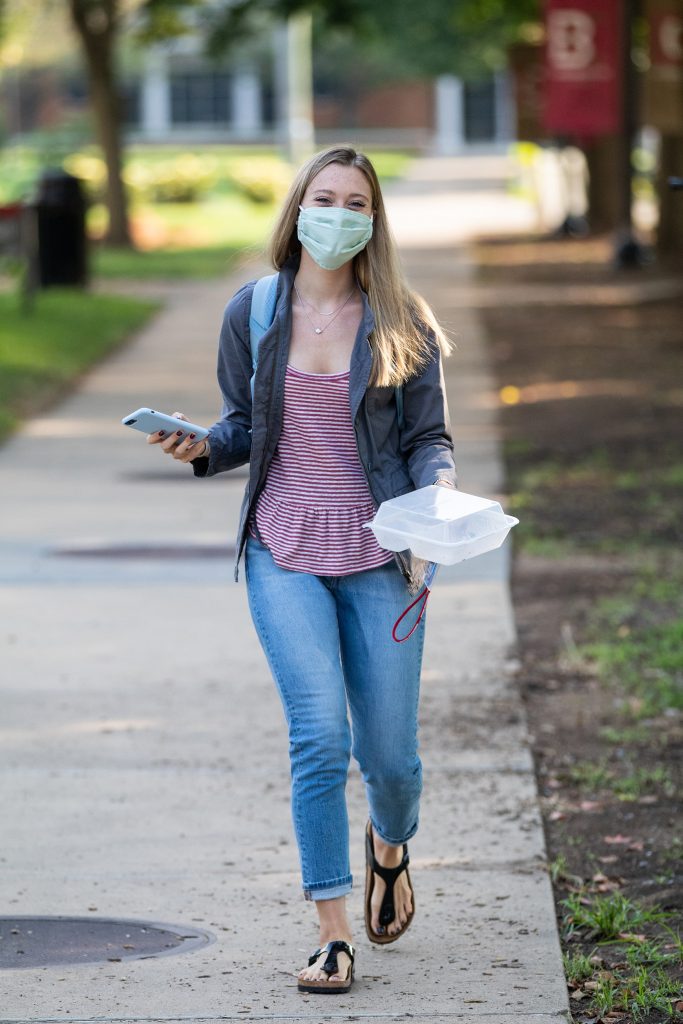
Another key to the College’s success has been frequent communication throughout the pandemic. A COVID-19 task force was established in March. Once the semester ended, that group transitioned to a reopening task force, with the goal of bringing back safely to campus staff, faculty and students. Regular updates were sent via email, as well as posted online at bridgewater.edu/covid19. The website also features a COVID-19 dashboard tracking multiple data points related to COVID cases on campus.
FAQs for students, staff and general campus information were highlighted on the website, along with information on the federal CARES Act: Higher Education Emergency Relief Fund grants, which awarded $575 to each Bridgewater student and an additional $899,990 to the College.
The College also received a $33,000 grant from the Virginia Foundation of Independent Colleges, which was distributed to students with special COVID-related circumstances, such as loss of jobs or lack of housing. In addition, the College received a $4.6 million Paycheck Protection Program loan, which helped offset lost revenue from room and board and other auxiliary fees when students pivoted to remote learning in the spring.
President Bushman said the College’s financial position going into the pandemic was solid, and that the College has invested wisely in the past decade, including improving technology and software infrastructure and outsourcing dining services and custodial services to larger companies.
“This moment was challenging, but we didn’t get through it by luck,” he said. “We got through it because we planned well for lots of things a long time ago.”
Bridgewater College faculty and staff looked to their counterparts at other schools in the state and across the nation for tips on best practices and how to navigate uncharted territory. President Bushman was part of a consortium of Virginia higher education leaders who shared reopening plans and strategies for maintaining in-person operations. Additionally, the presidents of BC, JMU, Eastern Mennonite University and Blue Ridge Community College have been in regular communication since March.
“We’re not competing with each other for the best COVID response, we’re learning from each other,” President Bushman said.
Bridgewater College staff knew that students’ decisions to return to campus would not be made lightly, especially with the possibility of having to pivot to remote learning again or for students and their families who were in a higher risk health category. Students were given the option to learn remotely for the fall semester, as each classroom was equipped to accommodate both in-person and remote learners simultaneously. Of the College’s total enrollment of 1,601 students, 468 opted to learn remotely in the fall.
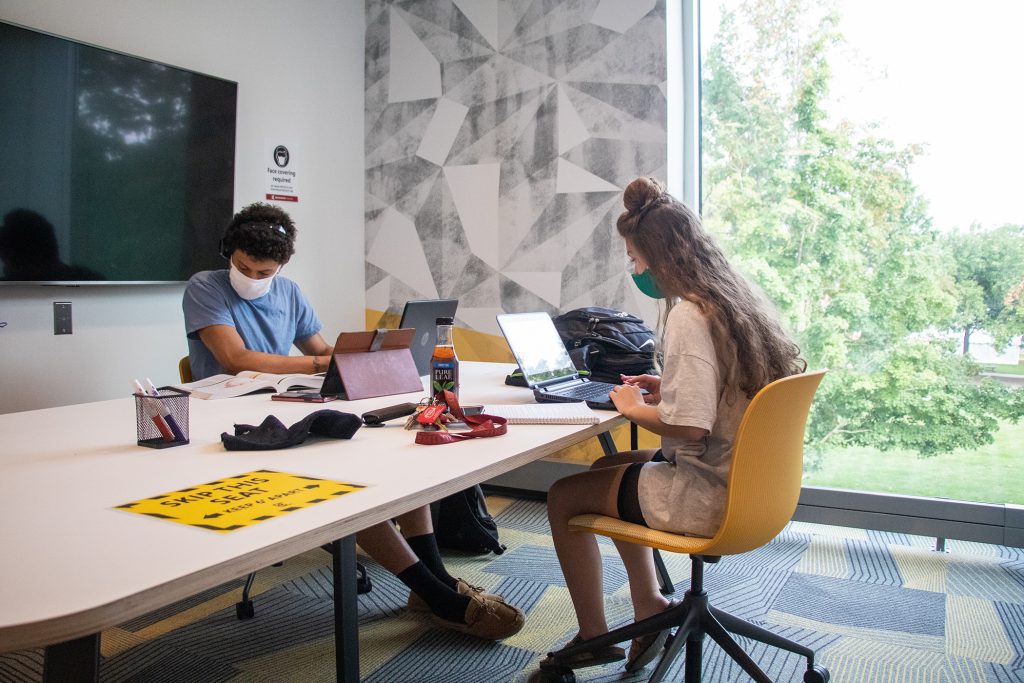
In addition, the College offered students the opportunity to waive the residency requirement and live off campus for the semester. The total number of students living on campus this fall was about half the total student body: 877 students.
“This was unprecedented in the sense of the speed with which it happened and the attention to detail that it took to be prepared to reopen,” President Bushman said. “It’s one of the parts of my professional career that I’m most proud of, that we were able to navigate through this.”
Before returning to campus this year, each student signed the Healthy Eagles Pledge, which stated the student would protect themselves, their peers and the Bridgewater community by following all health protocols, including wearing a mask on campus and following physical distancing rules. Bridgewater’s testing and monitoring of COVID-19 is led by Health Services through its partnerships with Carilion Clinic and the Virginia Department of Health (VDH).
“The enthusiasm our students have for coming back, even with classes looking different and having to socialize in different ways, their willingness to do those things to be here in person underscores the pride they have in their institution,” said Dr. Leona Sevick, Provost and Vice President for Academic Affairs.
In the wake of the continuing health crisis, there is no way to predict how the semester and the rest of the academic year will unfold, but President Bushman affirms the College has remained vigilant in monitoring the health situation both on campus and in the local community, as well as followed all state and national mandates. The College is prepared to pivot to remote learning if necessary.
But pivoting to remote learning again, whether short term or long term, would look vastly different from the past spring, as the last few months have been a major period of learning for every member of the BC community.
“One of the lessons we’ve learned from this is that we actually can do this,” President Bushman said. “It’s like everything else: You learn by doing.”
Admissions: Connecting with Prospective Students
When the pandemic struck, enrollment indicators were up for the 2020-21 academic year, including a higher number of admitted students visiting campus—many who had visited multiple times. According to Jarret Smith ‘03, Director of Admissions, it’s the on-campus visit that truly conveys the Bridgewater experience and generally solidifies a student’s decision to attend.
But COVID-19 changed everything, not only by shutting down the campus to visitors for months, but also by altering the Admissions team’s approach to connecting with prospective students and their families.
One creative solution was the prospective student campaign in which more than 100 members of the BC community—faculty, staff, alumni and student ambassadors—spent time penning notecards, making phone calls and sending emails to 2,500 prospective students, sharing personal stories of their time at Bridgewater and what makes it so special.
Virtual tours and Zoom sessions with high school students also played a role in showcasing the College, and continue to be part of the Admissions office’s approach to recruitment this fall.
In-person tours resumed in July and are done one-on-one with individual families. Each family member and tour guide wear masks the entire time, and 80 percent of the tour takes place outdoors, to ensure adequate distancing and to limit the time indoors together.
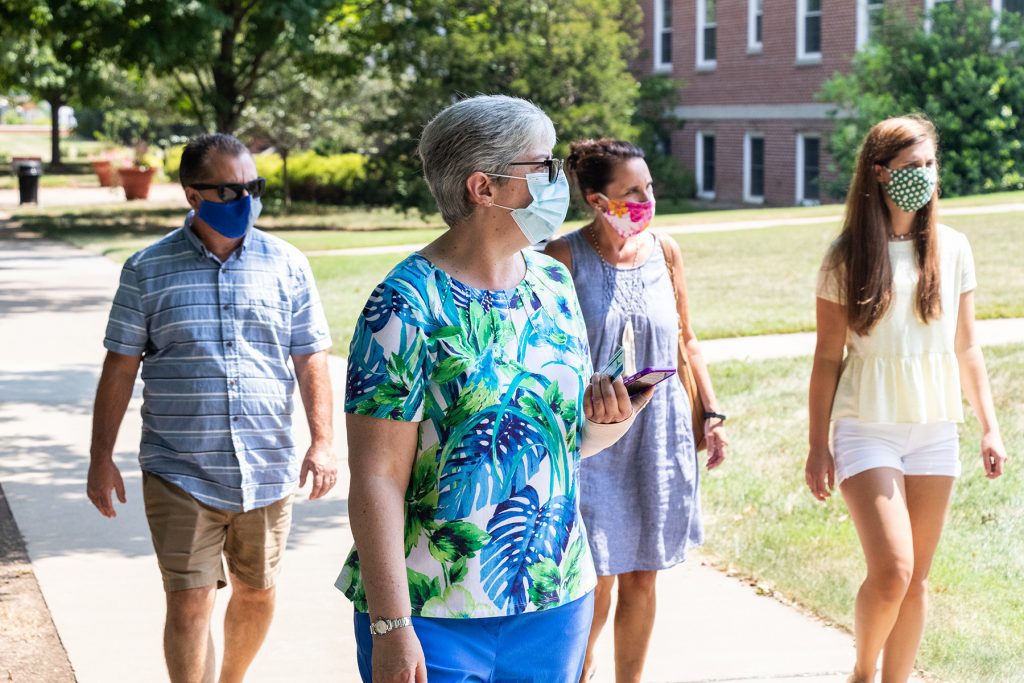
“Visitors have been comforted by our communication of expectations for on-campus visits,” Smith said. “People see that we’re taking every measure possible to ensure our safety and theirs.”
Another decision to aid students was the announcement in July that the College would be shifting to a test-optional policy for incoming students. Students may now choose whether to submit ACT or SAT test scores when applying to Bridgewater. The move, which will be in effect and evaluated for the next three years, was something the Admissions office was considering well before COVID-19, as it recognizes that standardized test scores are not the primary factor determining student success. More than 1,000 four-year colleges and universities across the country have adopted this policy, including Roanoke College, James Madison University and Christopher Newport University in Virginia. Smith said the change came at just the right time, as some students have had difficulty scheduling a test due to COVID-19 restrictions.
“We want to meet students where they are,” he said.
Going into the fall, tours on campus—both virtual and in-person—were up 2 percent. “I feel good about our future,” Smith said.
Alumni Relations: Preserving Bridgewater Bonds
Bridgewater College’s Alumni Relations office also had to make some major pivots this year. One of the office’s biggest events is Eagles’ Night Out, which draws together hundreds of alumni in multiple cities across the country. This year’s event was held in a virtual format, with Provost Sevick, Vice President of Student Life and Dean of Students Dr. Leslie Frere and President Bushman in a panel at the John Kenny Forrer Learning Commons. The livestreamed video received more than 1,000 views. The event also featured a tour of the Learning Commons with President Bushman and Forrer Learning Commons Director Andrew Pearson.
Senior Director of Alumni Relations and Annual Giving Colby Horne said a focus on digital communications has allowed new ways of connecting with alumni, especially the younger generation. Horne’s team is working with the Athletics department and chairs of each academic department to host monthly virtual events for alumni. These have included a live Zoom event with Head Football Coach Mike Clark and a bird-identification presentation from Associate Professor of Biology and Department Chair Dr. Robyn Puffenbarger.
“These are things we wouldn’t have done otherwise, and we’re thinking they will be great ways to stay connected going forward,” Horne said.
Another new program born out of the COVID-19 pandemic is the pilot for the BC Connect Mentorship program, which kicked off this fall. Alumni mentors are matched with student mentees, and the pairs will meet virtually to establish a relationship and discuss items such as professional development opportunities and career goals.
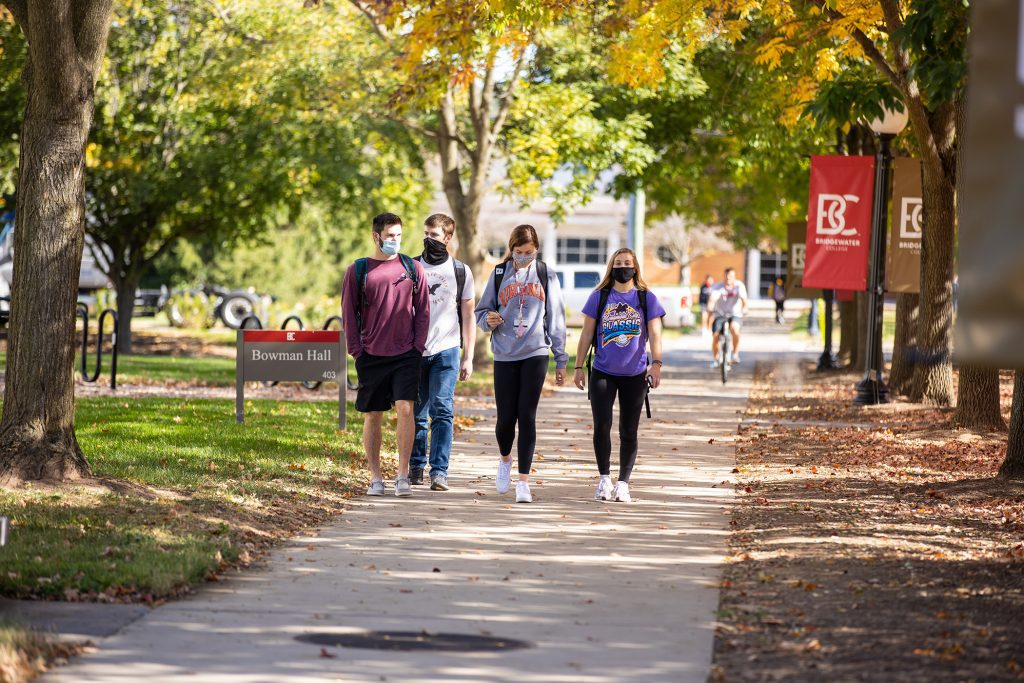
“We hope the students feel supported and are matched up with someone who went through what they are experiencing and can share advice on their career,” Horne said. “That’s the beauty and benefit of Bridgewater College, that we are small enough to have these personal connections.”
Unfortunately, the biggest on-campus alumni event of the year—Homecoming—was cancelled due to safety concerns for both alumni and students. Horne said the campus generally welcomes back more than 1,000 alumni to campus for reunion events and homecoming sporting events during the weekend, with an estimated 1,500 to 2,500 people tailgating in Mapp Field before the football game. The College plans to host two 50-year reunion groups next year, Class of 1970 and Class of 1971, with the opportunity for combined events.
“We hope next year’s Homecoming will be bigger and better,” Horne said. “It’s our biggest event of the year and we’re disappointed we couldn’t have it this year, but we are hoping to have the opportunity to do it next year. Connecting in person is the goal.”
Athletics: Embracing New Opportunities
In July, the Old Dominion Athletic Conference (ODAC) Presidents Council voted to postpone fall and winter sports until after Jan. 1, 2021, in light of the public health landscape and the unique challenges presented by athletic competition. At Bridgewater, that meant a non-traditional approach to the sports seasons while still maintaining connections between student-athletes and coaches. Each sports team is practicing three days a week until Thanksgiving at the latest. The practice sessions take place with individuals and small groups and are focused on strength conditioning and skill development. Student-athletes and coaches/trainers follow both Bridgewater College and NCAA COVID-19 safety guidelines during each session.
“It’s really given us an opportunity to train and develop our student-athletes over the fall,” said Athletic Director Curt Kendall ‘81. “In reality, coaches are getting more time with their athletes than they did in the past.”
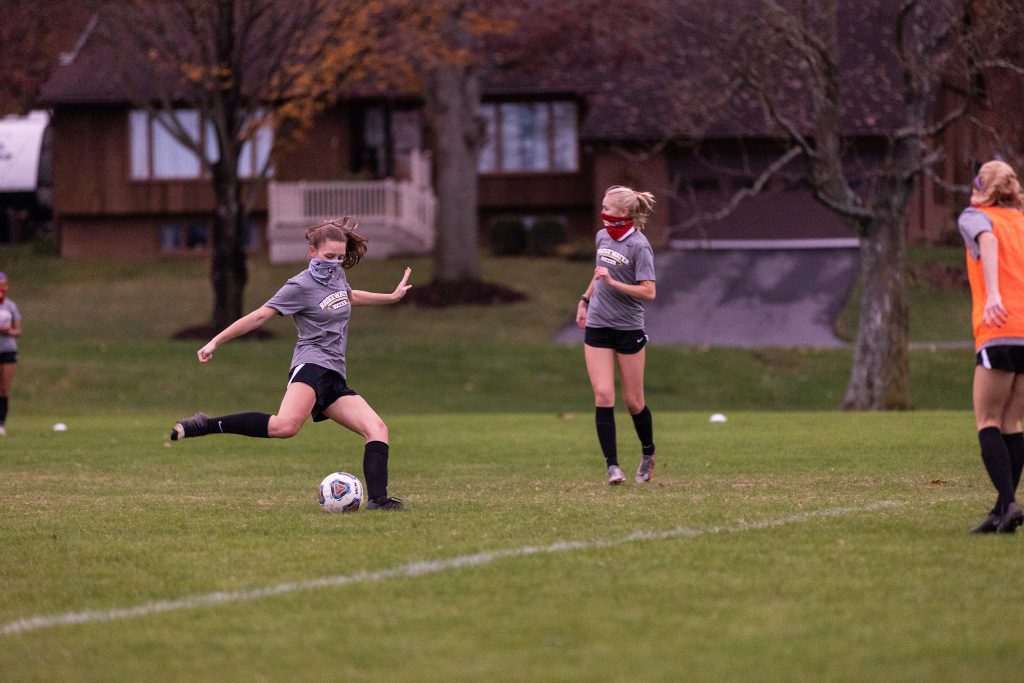
The ODAC is still determining how to incorporate fall and winter sports into the spring schedule. The goal, Kendall said, is to hold a championship for each sport.
“Our goal is to provide the best student-athlete experience that we can while working with the guidelines we’re given,” Kendall said.
Kendall said he is pleased with the preparation both coaches and student-athletes put forth to return to campus and reunite with their teams.
“You always teach your student-athletes to be able to make adjustments, whether that’s in a game or in life,” Kendall said. “I think we’re pretty resilient people in athletics, whether we are coaches or players. Instead of being worried about what we can’t do, we focus on how can we move forward and make the most of the hand we’ve been dealt.”
Academics: Maintaining the Bridgewater Experience
The Bridgewater experience is built upon in-person connections among faculty and students, as well as peer-to-peer interactions in the classroom. When the College pivoted to remote learning in March, the biggest concern academically was how to maintain that level of connection and engagement in a remote learning environment.
Once the decision was made to remain online for the rest of the semester, the College organized training sessions for faculty on how to use virtual classroom tools such as Zoom and Panopto (lecture-recording software), including strategies for synchronous learning with an entire class at one time. Emily Goodwin, Director of Instructional Design, says the Information Technology (IT) Center offered 15 training sessions for faculty in March and April.
“It was learning all the software that’s available to them and maintaining the expectations and the community feel and the connections they already had with students for the rest of the semester,” Goodwin said.
One boon for Bridgewater was the change in online learning systems from Moodle to Canvas in fall 2019. As a cloud-based program, Canvas is more accessible and user-friendly with apps for both students and faculty. In addition, the College has invested in shoring up its IT infrastructure, to ensure seamless operations in the wake of an emergency.
“We were prepared for something like this, infrastructure-wise,” said Kristy Rhea ‘02, Director of Information Technology. “The College has put the right funding into our infrastructure, which allowed the campus to pivot to remote learning fairly easily.”
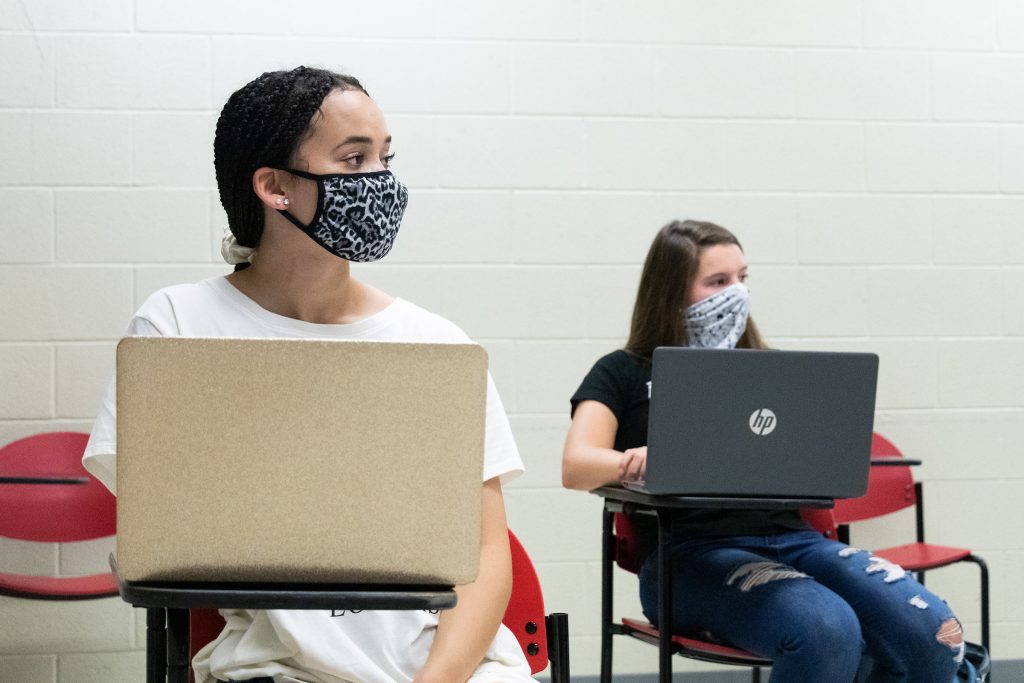
Provost Sevick had a unique vantage point during the spring semester. Both she and President Bushman were teaching in the spring: she, Asian American Literature, and he, Introduction to Biology.
“It was fortunate that we were in the same predicament as the rest of the faculty because we could anticipate some of the issues and also empathize with the challenges of teaching in that environment,” Sevick said.
Sevick had never taught an online class before, and she learned quickly that recreating a formal classroom environment was not possible. Students were Zooming from their bedrooms and living rooms. And some were dealing with issues beyond school work, such as helping to take care of younger siblings or living with family members who have a health risk. Sevick, a practitioner of yoga for 18 years, started incorporating breathing exercises at the beginning of each class, as a way to help students stay focused. As the days went on, she began leading her students through a few yoga poses as well.
“It gave them something new and something to look forward to,” she said.
One benefit of embracing a more casual classroom environment was that some students who had previously been less likely to speak up in class were talking more and engaging in new ways. Sevick also strategically employed the use of Zoom breakout rooms, in which she could randomly assign groups of students to discuss classroom material. Getting out of the traditional classroom setting allowed for new interactions.
“More than ever adaptability is the key to success in the classroom,” Sevick said.
IT’s Goodwin agreed, commenting that online teaching requires a different design in instruction and in how course content is presented. Beyond the spring training sessions with faculty, her team led 25 additional summer sessions with faculty that were focused on the BC flex learning model (a hybrid of in-person and remote learners in one class), how to hold effective online discussions and an overview of additional teaching resources such as Flipgrid and Panopto.
Sevick and President Bushman met with faculty remotely over the summer in multiple town hall sessions. The main message was to be prepared for a new kind of teaching and learning environment, especially the potential of going all-remote, in the fall.
“It’s a new kind of teaching for many of us, and the faculty has been very good about retraining with goodwill,” Sevick said. “We want to make sure we engage students, help them learn and keep them interested in learning.”
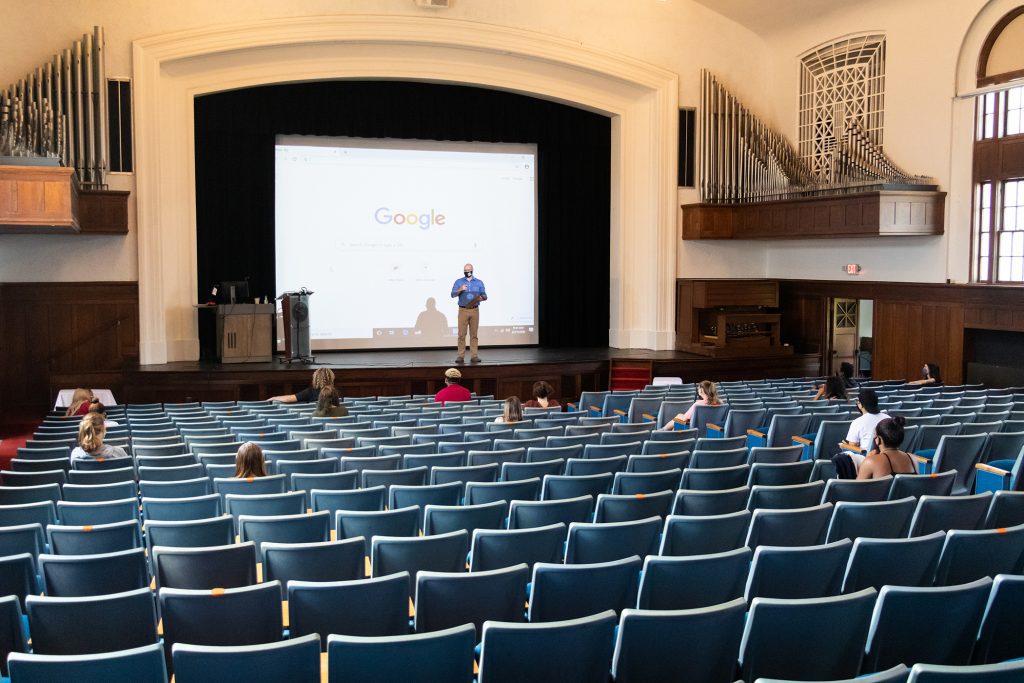
Several of the College’s division heads co-led virtual classroom simulations, with some faculty and staff in the classroom and some participating online. The goal was to simulate how the BC flex model would work, and to also give faculty an overview of what the new classroom spaces looked like.
Sevick said one of the biggest challenges was reconfiguring the College’s classrooms into distanced spaces that would allow for students to learn in person. Facilities staff and division heads spent the summer measuring each classroom and reconfiguring desks and furniture to allow for physical distancing. Each classroom space was outfitted with a web camera in anticipation of remote learners, as well as a document camera so that professors could simultaneously project something onto a classroom screen and a Zoom screen to students at home.
The College also marked for classroom use the President’s Suite, Boitnott Room, Concert Hall and Stone Chapel in the Carter Center for Worship and Music, and the auditorium in Cole Hall.
“Even though the circumstance is new, adaptability is key,” Sevick said. “Faculty understand working with students who learn in different ways and who thrive in different environments. More than ever adaptability is the key to success in each classroom.”
Dr. Christine Carrillo, Associate Professor of Music and Department Chair, has determined how to adapt COVID-19 protocols not only to the classroom but also to musical practice. As COVID-19 is primarily thought to be transmitted through aerosols, musical ensembles with wind instruments and choral singing in enclosed spaces were particularly worrisome. Carrillo used a scientific study done by the University of Colorado to help determine what the fall musical landscape at Bridgewater would look like. As a result, Carrillo implemented several changes this fall, including purchasing musicians’ masks with slits for mouthpieces that students wear while playing, as well as bell covers branded with the BC logo for the end of brass and woodwind instruments. Choral members are required to be spaced out 12 feet apart in the Concert Hall and wear masks throughout the duration of a practice. Carrillo also limited the number of students in the Symphonic Band to only 10 to 15 students playing together at a time, and established additional chamber music quintets and small ensembles to give students additional group performance outlets. One-on-one applied lesson music instruction takes place both through Zoom and in person.
“The students have been exceptionally resilient through all of this,” Carrillo said. “I know it’s not an ideal learning environment for music, yet they’ve all come together and realized we’re doing the best we can.”
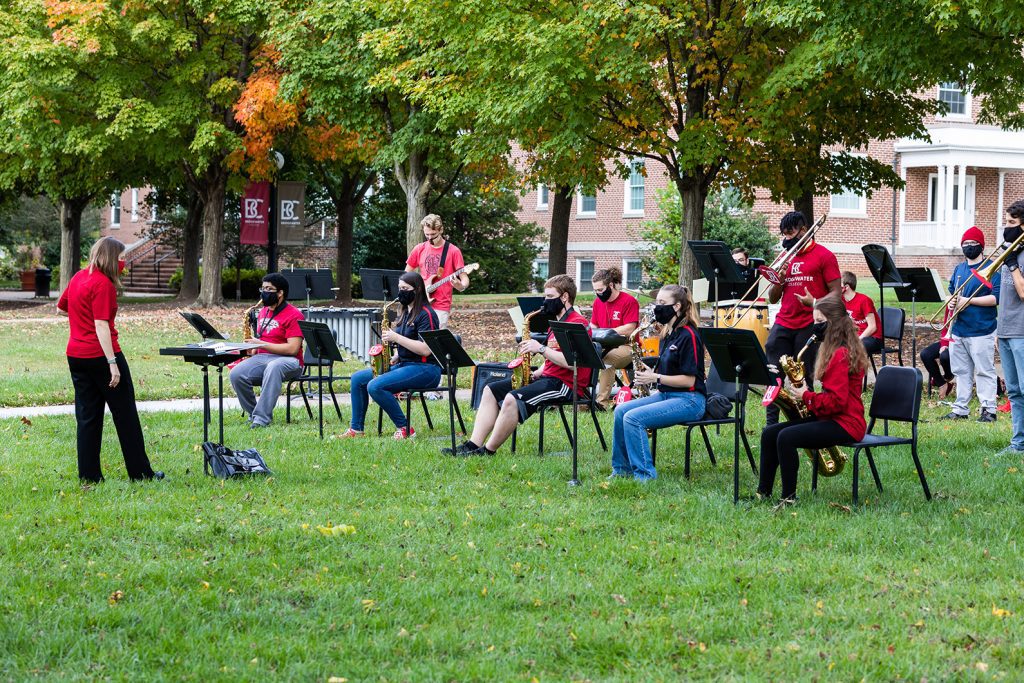
No indoor public musical events will take place on campus this fall, although Carrillo is planning a few outdoor performances for those on campus, such as the Oct. 1 mini concert the Jazz Ensemble gave on the campus mall. She knows the importance of musicians not only connecting with each other but bringing music to the whole community.
“Seeing the returning students meet all the new students and watching those relationships grow through music is just heartwarming for me. The exciting part about planning this summer has been finding ways to keep people engaged in music safely, and I think we’ve found a lot of good ways to do it,” Carrillo said.
The sciences are another area of instruction with significant changes due to COVID-19. In the spring, Dr. Robyn Puffenbarger was teaching a field-based ornithology class as well as molecular biology labs. Her ornithology classwork translated well enough to remote learning, as students made observations in their backyards and elsewhere. But the normally hands-on biology labs were a bit trickier. Puffenbarger created demonstration videos of herself in the lab each week through Panopto and shared them with students.
“It’s like watching a chef on TV instead of doing the cooking yourself,” she said.
A hallmark of the Bridgewater experience is gaining hands-on laboratory knowledge as an undergraduate, Puffenbarger said. When BC students go on to graduate school, they often have more direct lab experience than their counterparts from larger schools.
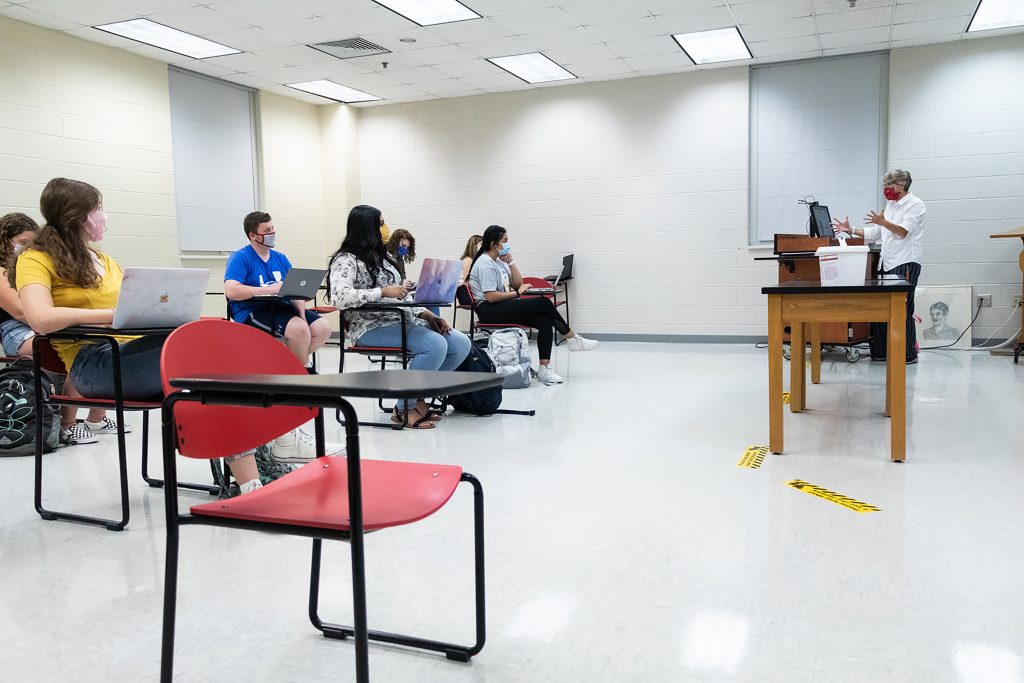
“One of the things I’ve always been excited about is we have the opportunity to see students in labs,” Puffenbarger said. “It’s a different way to get to know them, and we can work on techniques they can use to move forward in their careers.”
In preparation for the fall, Puffenbarger purchased four simulated biology labs from a company called SimBio, so that she could provide as close to an in-person lab experience as possible if the College pivoted to all-remote learning. She brainstormed ways her genetics lab could function as a take-home lab for remote learners. For in-person lab work, students wear masks and add face shields if needed. And web cameras in the lab are used to demonstrate experiments to remote learners.
“This is definitely something new, but could be very useful in the future,” Puffenbarger said.
Student Life: Reimagining Engagement
When the College pivoted to remote learning in the spring, the main focus for the Department of Student Life was the well-being of students. Students were navigating life in a global pandemic while still processing the loss of their college experience, especially seniors. They had to leave their friends, mentors and jobs or internships, and return home to finish out the semester.
The department maintained its focus on engagement with students throughout the semester and during the summer by embracing the virtual format and continuing to offer events such as Desserts with the Dean and virtual bingo. In April, Student Life recruited staff members from other departments to help call every returning student to check in and see how they were doing. In addition, Counseling Services staff stayed in touch with students throughout the spring, summer and fall, and began offering additional remote group sessions.
“I think what we do really well at BC is placing our importance on community,” said Dr. Leslie Frere, Vice President for Student Life and Dean of Students.
Whitney Smith ‘01, Assistant Dean of Students, led the charge in reimagining summer orientation from in-person sessions to online sessions for incoming students and their families.
Student Life began a pro-social media campaign this summer to share with students the expectations regarding mask-wearing and social distancing, as well as why each measure keeps the BC community safe. Coordinator of Student Engagement and Leadership Sam Schlernitzauer worked with the Office of Marketing and Communications to produce a video that walked students through spaces on campus to show them what campus life would look and feel like upon their return.
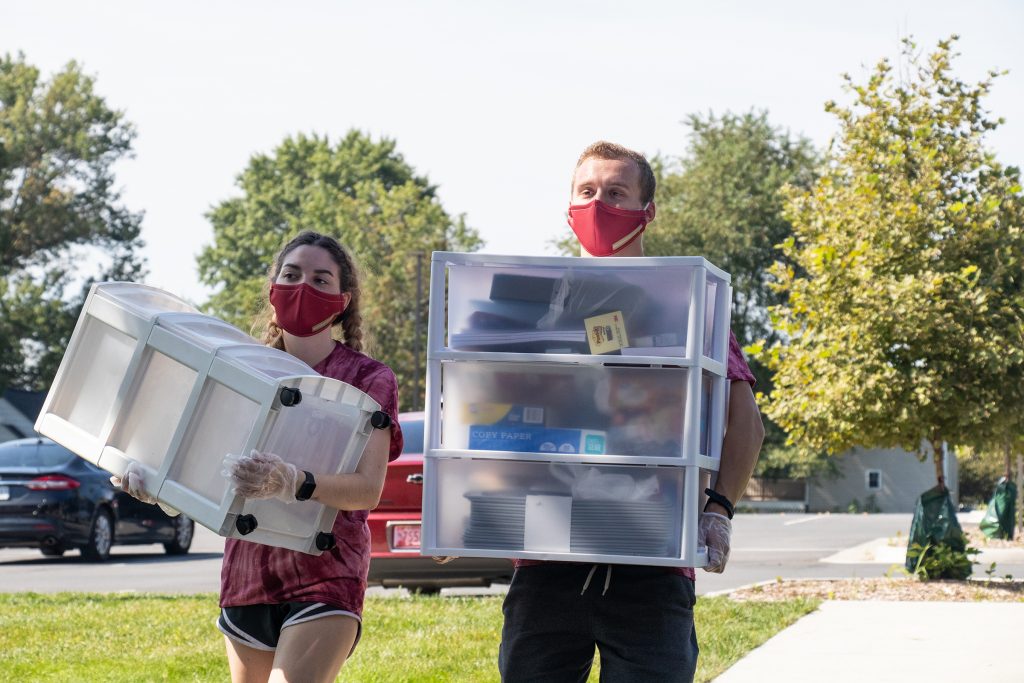
For move-in, each student signed up for a designated one-hour time slot in which they and one guest could move in their belongings.
All Welcome Week activities, including educational sessions, a movie and a virtual Welcome to the College event, were held outdoors via large screens set up on the mall and in front of the McKinney Center. Students were required to wear masks and maintain physical distancing at all events.
“We’re doing the best we can, whether on campus or virtual, so that students can still call it the Bridgewater experience,” Frere said.
This fall, students have been encouraged to be outside as much as possible, whether studying in a small group or socializing with friends. And Student Life events are offered both in-person and virtually.
“This really transformed the future of higher education in terms of how we do things and approach things,” Whitney Smith said. “It catapulted us into a new normal, and I think some of these things will exist even after all of this. I think it was a good reminder to think creatively and be highly adaptable.”
